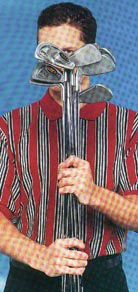How not to make a prat of yourself
Tips to save your shame

The clubhouse bar is the place where we usually describe our rounds – and buy the occasional one! – and where rarely anyone listens to a word we say for fear of missing the opportunity to chip in with an anecdote of their own.
 |
Discussing the round the other day in the bar – well is there a better place? – I noticed one of my regular colleagues sat alone in the corner, mumbling into his Guinness.
"What’s the problem?"
Without lifting his head he said: "I had a ‘mare (nightmare) and made a right prat of myself."
It turned out that not only had he shot a score eight over his normal handicap on the front nine alone but his grey cells were so out of sync he’d left a club on the course, flubbed two successive chips from the edge of a green and finally lost his temper with a back-handed attempt at a double-bogey putt that he kicked the ball away in disgust.
In his misery he was about to give up the game but recognised tomorrow’s another day and one or two successful shots he played were, on reflection, enough to bring him back to a first tee, sometime soon.
Let’s look a few nightmare scenarios and understand how with a little discipline we can avoid them happening.
Never take a ‘tap-in’ for granted
If it’s more than 12 inches from the hole, it’s still missable. Treat every putt the same. Square your shoulders, square the blade, take the putter back and through. If you’re likely to step on someone’s line ‘to finish off’, mark it, step back and wait. Whether it’s a 250-yard drive or a putt that’s hanging over the hole, it’s still ‘one stroke’ on your scorecard and demands just as much concentration.
Fluffed chip from the edge of the green
We’ve all done it, even the pros, though theirs is usually down to the difficulty of the lie or conditions at major events rather than bad technique. The secret is to watch the ball, not where it’s going.
Because the ball is lying awkwardly or you’re undecided as to whether to putt it through the rough rather than chip it, you get anxious. When you get anxious you get ahead of yourself and go looking for the result too soon.
Keep your eyes on the back of the ball at the point you want to make contact until you have counted ‘one-two’ after impact. That will stop your head coming up too soon.
Faced with a pressure drive
We’ve all stood on the tee thinking negative thoughts – ‘mustn’t slice this’… ‘please don’t let me hook it’… ‘If I top this, I’ll never reach the green.’
A pal of mine has recently returned from a group coaching holiday in Spain with Jos Vanstiphout, the Belgian psychologist who helps Ernie Els, Darren Clarke and Retief Goosen.
He didn’t want to reveal too much before he took my £2 side bet but commented that one tip he’d been given was to keep his mouth open for crucial shots when he swung. Apparently it releases tension. It worked for me a couple of times, especially off the first tee. So remember, when you’re up, say ‘Aaaargh!’

